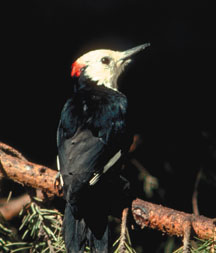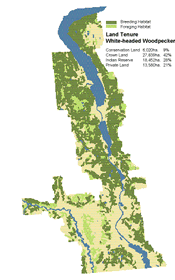|
Habitat Atlas for Wildlife at Risk
White-headed Woodpecker
Picoides albolarvatus

White-headed
Woodpecker
|

- Length: 24 cm.
- Snow-white head and throat contrast sharply with
black body.
- Males have red patch on the back of their head.
- White wing patches are conspicuous in flight,
visible as narrow bars when wings are folded.
Status:
British Columbia Red List
Canada: Threatened
Special Significance
The small Canadian population of White-headed Woodpeckers
is restricted to mature and old-growth ponderosa
pine forests of the south Okanagan Valley. These
birds feed on pine seeds through the fall and winter,
and the great majority of pine seeds in a forest
are produced by large, mature trees. The open, park-like
pine woodland habitats favoured by White-headed Woodpeckers
has been replaced over the last fifty years with
denser stands of small trees, due to early selective
logging and subsequent fire suppression. Attempts
should be made to protect existing mature and old
growth stands and to manage young forests to produce
more open habitats with faster growing trees interspersed
with a few dead snags for nest sites. The public
can help these rare birds by encouraging the implementation
of beneficial forest management practices, and by
applying them on their own woodlots. Without a well
distributed supply of mature ponderosa pine, it will
be difficult to maintain a resident population of
White-headed Woodpeckers in British Columbia.
Distribution
- In Canada, the White-headed Woodpecker is known to breed only
in the Southern Okanagan Valley north to Naramata.
- In recent years, this woodpecker is only sighted once
or twice annually.
- There are records of wandering birds elsewhere in
the southern Interior, from Manning Park north
to Falkland and east to
Golden.
- Elevational range of breeding habitat from 450 to
600 metres in open ponderosa pine.
Habitat
- White-headed Woodpeckers require mature and old growth ponderosa
pine forest with large diameter, decaying trees
for nesting and roosting, and abundant seed cones for food.
- Nests have also been found in Douglas-firs and western
larches.
Reproduction
- Primary cavity nesters-excavating a new cavity every year for
their nest, sometimes beginning several holes before selecting one.
- Nest cavities are relatively close to the ground (3
to 9 m).
- Establish breeding territories in spring.
- Females lay 3 to 9 eggs (usually 4 or 5) mid-May to
mid-June; the eggs are incubated by both the male
and female for about 14 days.
- Both parents feed the young in the nest for about 26
days; nestlings may fledge as early as late June.
Food Habits
- Relies on ponderosa pine seeds for sustenance especially in late
summer through winter.
- Birds slash cones open to get at seeds.
- Insects such as ants, wood-boring beetles, spiders
and fly larvae, can dominate the woodpecker's diet
in spring and early summer.
Interesting Facts
- Unlike most other Canadian woodpeckers, this species relies less
on insects and more on seeds for food.
- When foraging for insects, these woodpeckers flake
and chip bark away with angled strokes rather than
peck at the tree directly.
- Fluctuations in the White-headed Woodpecker's population
are believed to occur naturally in response to
climate and other factors that affect ponderosa pine seed production.
Threats
- Loss of mature and old growth ponderosa pine forest
due to logging in the 1930s and 1940s;
residential development, fire suppression, felling deteriorating
trees (snags) and cutting
for firewood threaten woodpecker habitat.
- Logging practices which remove all or most of the
mature and old growth trees in a stand.
- Small population size, restricted range and narrow
niche combine to make this bird vulnerable.
Management Considerations
- Encourage selective logging practices rather
than clear-cutting; logging can serve to
thin dense stands nearing maturity and remove competing
trees.
- Improve and sustain old growth ponderosa pine
forest.
- Allow successional forest stages to mature to
old growth.
- Thin young stands to maximize growth and cone
production.
- Retain dead or dying standing trees, especially
soft, large diameter snags.
- Discourage use of forest insect pesticides in
their habitat.
|
References
1. Blood, D.A. 1997. BC Wildlife at Risk brochure: White-headed Woodpecker.
BC Ministry of Water, Land and Air Protection, Lands and Parks.
2. Campbell, R.W., N. K. Dawe, I. McTaggart-Cowan,
J. Cooper, G. Kaiser and M.C. McNall. 1990. Birds of British Columbia:
Volume 2. Royal British Columbia Museum,Victoria, BC.
3. Bryan, A.D. and M.J. Sarell. 1994. White-headed
woodpeckers. South Okanagan Similkameen Stewardship Program.
|